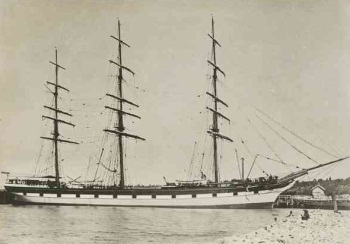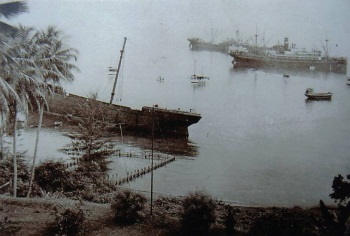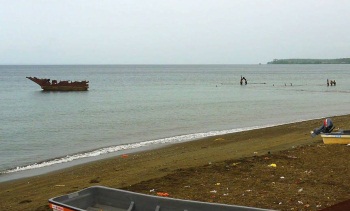So what has the Scottish Loch Katrine to do with PNG? Maxwell Hayes

PRG 1373/15/4. Loch Katrine 1880 Courtesy of State Library
Named after a Scottish lake, the rusting remains of this once magnificent clipper have been very visible on one of our Papua New Guinea foreshores since 1924. Of the thousands of residents and others most people passing her, or being aware of her, would know little about this once great clipper lying as an abandoned hulk near Kokopo. The rusting remains have now almost finally disappeared under the sea which very nearly took her more than one hundred years earlier.
This iron, steel, wood and canvas square rigged three masted clipper 226′ in length, 35′ beam and 23′ draft of 1,252 gross tons, was once one of the 25 colonial clippers, all named after Scottish lakes and owned by the ill-fated Loch Line of Glasgow (1867-1911) plying between the United Kingdom and Australia bringing immigrants, machinery, materials, textiles and so on and returning with grain, wool and other exports. She was built in Glasgow in August 1869, by J.G. Lawrie and Company and made her maiden voyage under the helm of Captain McCallum from London to Melbourne in the same year taking 81 days and over the years made many uneventful voyages between these countries.
On 6 December 1895, en route from Geelong to London, she ran aground on the Thames River and total destruction was feared, however tug boats saved her from disaster. The Rabaul Times of 5 May 1933 reported that the former clipper was configured as a barque in 1910.
On Saturday 23 April,1910, under the command of Captain T B Martin with a crew of 22 and with about 600 tons of cargo, the Loch Katrine left Melbourne for Sydney.
Her glamourous career as an ocean going clipper was to end on 27 April 1910, near Gabo Island, off Malacoota, southern NSW. At 2.30 am a severe hurricane struck her and in the next few hours all three masts splintered and toppled, crashing to the decks along with the crane, very luckily not piercing the steel hull. Pumps were smashed, one of the main compasses was washed overboard, three lifeboats were damaged beyond repair and she rolled so much to each side that the deck railings came under water. Control was totally lost in very heavy seas. The crew worked tirelessly until 2 May to clear the fallen shattered masts and other wreckage as she drifted where ever the tides took her. On Tuesday 3 May, with the weather abating, at 2.30 pm, six volunteers under the command of the Chief Officer George Smith with ten days provisions set out in the sole remaining life boat to head for land believed to be about 80-90 miles away.
By chance, on Friday 6 May, the crew of the Swedish steamer Tamanic under the command of Captain Hakamason, en route from Sydney to Adelaide, sighted and rescued the crew, arriving at Port Philip Heads, Melbourne, on Saturday 7 May, where she dropped off the rescued sailors to a pilot vessel and continued on her voyage.
At Melbourne, signals were exchanged with Sydney shipping agents and the tug Heroic set out, located the floating hulk east of Jervis Bay, NSW, returning with the battered hulk and the remaining crew in tow to Sydney on 10 May. Later she was purchased by Dalgety and Coy, wool merchants of Sydney. In 1911, after being refitted with engines and a new superstructure, and registered in Sydney, she spent the next years carrying coal around the Australian coastline. The Loch Katrine’s days of being under sail ended forever. An inglorious career for such a fine vessel.
In May 1924, the Loch Katrine was purchased by Burns Philp and Co. Ltd and towed to Rabaul where for some years it was used as a coal lighter for ships of the Burns Philp line.
Former Warrant Officer, James Buckingham Stratton (1905-2007), of the New Guinea Police Force 1927–1929, whom I contacted in 2005 remembered conveying the ringleaders of the mutiny by the Rabaul native police and town labourers, under armed guard, to the Loch Katrine which was to become their temporary prison until relocated elsewhere in the Mandated Territory. Among those confined on the Loch Katrine was a Manus senior Sergeant Major N’Dramei (Rami),nominally the leader of the 200 native police taking part with numerous town labourers in the January 1929 Rabaul town mutiny.
The Loch Katrine hulk was towed to Kopopo and a 1930s picture in Pacific Islands Monthly (August 1964) shows her used as a breakwater for the Burns Philp jetty near the company’s store at Kokoko. Eventually she was towed and beached as a breakwater near Vunapope.

Photo taken by Dr H.C. Hosking in May 1937 (Dr Hosking was lost on the Montevideo Maru). At rear are the Golden Bear and the Montoro. Courtesy of his daughter Mary Symons. Interesting as this was about the time of the 1937 eruption
Having survived everything which storm, the intensive bombing of Japanese occupied Rabaul during WW2 and the natural ravages of the sea had thrown at her, the rusting remains of the Loch Katrine may be around for a few years yet to come, before she finally slips silently below the waters which nearly claimed her more than a century before.



